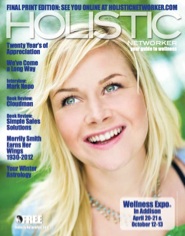By Dr. David G. Lancaster, DO, ABHM
Tai Chi is a low impact exercise that brings together movement, breath, balance, awareness, and serenity. As a martial art it involves the synchronization of breathing and thought with flowing movements of the trunk, arms and legs. These graceful movements have been choreographed over the centuries so that by the end of the routine the participant will have turned to face all four directions.
When assuming the postures the hips and knees are slightly flexed, the arms move through the air gracefully, while weight is constantly shifted between both feet. Often, balancing on one foot is held for several seconds while slowly turning to face different directions. This requires a dynamic ability to maintain balance, and the endurance to stay erect while moving to a new position. To accomplish this, the mind must be cleared of superfluous thoughts, and become focused on the precise location of each body part as they move through the forms. In this way, Tai Chi becomes a mental exercise in meditation.
The word ‘Tai’ translates to “big, extreme,” and ‘Chi’ translates to “excellence.” Together the words ‘Tai Chi’ take on the meaning of “ultimate, eternal existence.”
Tai Chi follows the tradition of yin and yang with the unity of opposites embodied in the postures. Yin represents negative and yielding power, while yang represents positive power and action. According to tradition, one can not exist without the other. Although they are in opposition, they are simultaneously complementary. Yin and yang movement themes abound in Tai Chi. In some postures the arms are held close to the body in a defensive manner but then open up to lunge outward while turning to a different direction. Weight is constantly being shifted between the legs to advance or retreat.
This philosophy of opposites in balance and harmony transcends the physical application of Tai Chi movements. It includes a way of thinking that can be applied to many situations, from social interactions to mental contemplation.
An example of a social application is when two partners in a relationship have a disagreement. If one of the partners holds a righteous position that is unyielding, a lover’s quarrel is bound to occur that results in hurt feelings. If, on the other hand, each partner is willing to discuss their individual positions, a verbal dance may take place when the partners yield their position a little in order to gain something else that they desire. In the end a balance, or compromise is achieved with the two opposing views.
An inward example is the mental sparring one goes through when trying to make a difficult decision. The risk and rewards of the choices are contemplated until a decision is made. Each choice has both positive and negative aspects that need to be considered. Making the correct decision requires mental or spiritual centering that allows the self confidence that the decision made is truly correct.
Although several legends exist about the origins of Tai Chi, it is agreed that it developed approximately 500 years ago in China. Tai Chi has evolved through the generations into several different styles, each carrying the family surname of the contributor. They include: Chen (the oldest), Wu, Sun, and Yang. Chen has large movements that are either quick or slow. Wu is mid-paced with compact movements, whereas the Sun style has quick compact movements. Yang is the most popular with 108 to 128 slow, long movements. A short form known as the Yang 24 is widely practiced in the US and is also the style most researched in the medical literature. Yang 24 was standardized by the Chinese National Council of Sports and Physical Education of the Government of the Peopleís Republic of China in 1956. It was adopted to reduce the complexity and time required to complete the forms.
Regardless of style, Tai Chi requires a focus of attention to the details of the movements that results in a heightened awareness of body to maintain balance and mental centering.
Tai Chi can be practiced at any age but is most popular with the older population in China. It requires moderate intensity with estimated demands of 2.6 to 4.6 metabolic units (METs). A metabolic unit is a way to measure cardiac demands during activity. It is defined as the bodies’ use of 3.5 milliliters of oxygen per kilogram of oxygen per minute of activity. In practical terms, lying quietly equals 1.0 MET, standing equals 1.2-1.6 METs, walking 3 mph is 4.3 METs, and jogging is 9 METs. Because of the low to moderate MET range of Tai Chi, it is an ideal form of exercise for those with chronic cardiac conditions. Tai Chi offers an advantage over some exercise forms because it requires no equipment–only a small, quiet space to perform.
There are close to a thousand papers published on Tai Chi. Of these only a handful are well designed. The majority of higher-quality studies examine Tai Chi’s effect on balance and cardiovascular outcomes. Fear of falling is common in senior citizens and can lead to activity restriction, decreased social activity, deconditioning, and even an increased risk of falling. Approximately 40% of healthy seniors aged 65 or older fall each year. Half of these result in minor injury, while 10% result in serious injuries requiring hospitalization.
A landmark study that provided the first evidence that Tai Chi reduced falls was conducted by Wolf, et al at Emory University. This study randomly assigned 200 older adults into one of three groups: Tai Chi, computerized balance training, or an educational control group. After 15 weeks the Tai Chi group reduced the risk of multiple falls by 47.5%. There was also a reduced fear of falling and a reduction in blood pressure.
In 2005, Li et al conducted a six-month randomized control trial to study fall reductions in senior citizens. Two hundred and fifty six people were randomly divided between a Tai Chi group and a stretching-exercise control group. At the end of six months, the Tai Chi group had significantly fewer falls and fewer injurious falls requiring medical treatment when compared to the control group. The participants also had a reduction in the fear of falling and improved functional balance.
There are several randomized controlled studies examining the effect of Tai Chi on cardiac function. Young et al, found a reduction in blood pressure following 12 weeks of Tai Chi. Participants were randomized into either a Tai Chi or aerobic exercise groups. Both groups had improvement in blood pressure. However, the difference between the two was that the intensity of the aerobic group was much more demanding. Aerobic mid-exercise heart rates reached an average of 112 beats per minute compared to 75 beats per minute in the Tai Chi group. The significance of this is that individuals with cardiac conditions, where intensive aerobic exercise is too dangerous, may be able to participate in Tai Chi and still receive similar cardiovascular benefits.
Several other studies found significant effects of lowering blood pressure and cholesterol, and a study at Harvard found an improvement of heart function in individuals suffering from congestive heart failure.
There are many fine studios in the Dallas/Fort Worth area to learn Tai Chi. Most are offered in martial art studios and community centers. The most important consideration when choosing a teacher is your comfort level with the movements and the rapport with the teacher.
There is mounting medical evidence that Tai Chi improves balance and has cardiac benefits. More studies are being conducted with respect to arthritis, osteoporosis, depression and concentration. Out of all the studies on Tai Chi there were very few complicating or adverse effects documented. Tai Chi is a safe and therapeutic exercise that only requires a small quite space to practice. It is a low impact exercise that brings together movement, breath, balance, awareness, and serenity.
Web Resources
www.nccam.nih.gov/health/taichi/
www.mayoclinic.com/health/tai-chi/SA00087
www.simplyaware.com
www.medicinenet.com/tai_chi/article.htm










